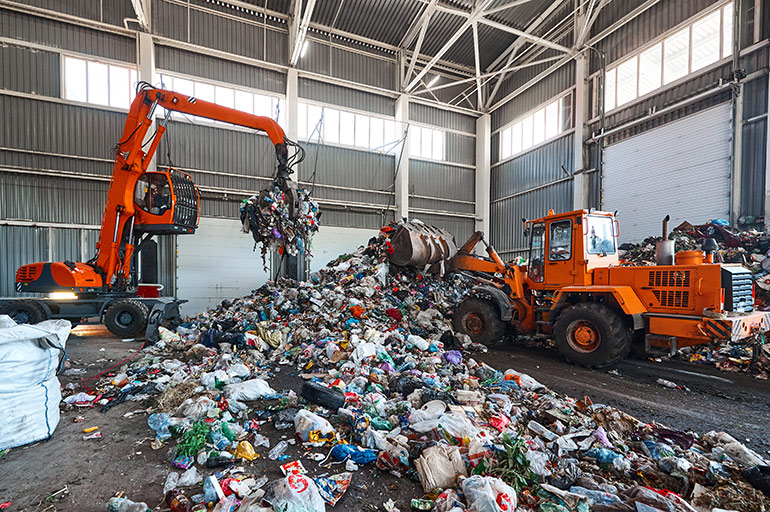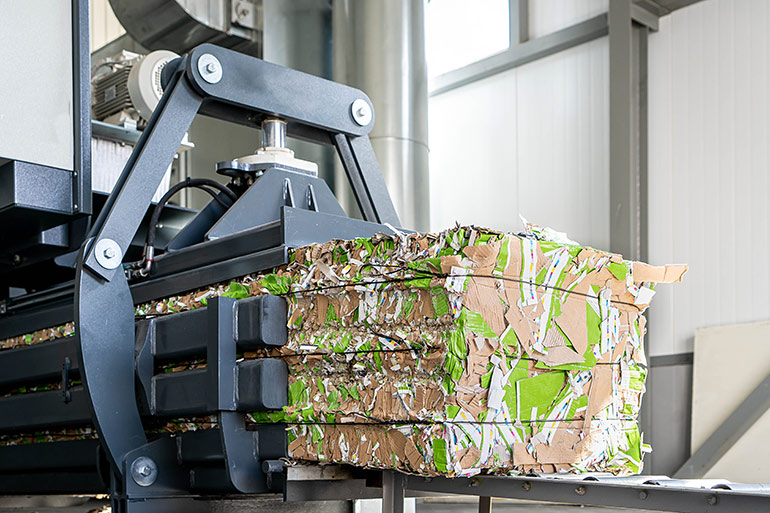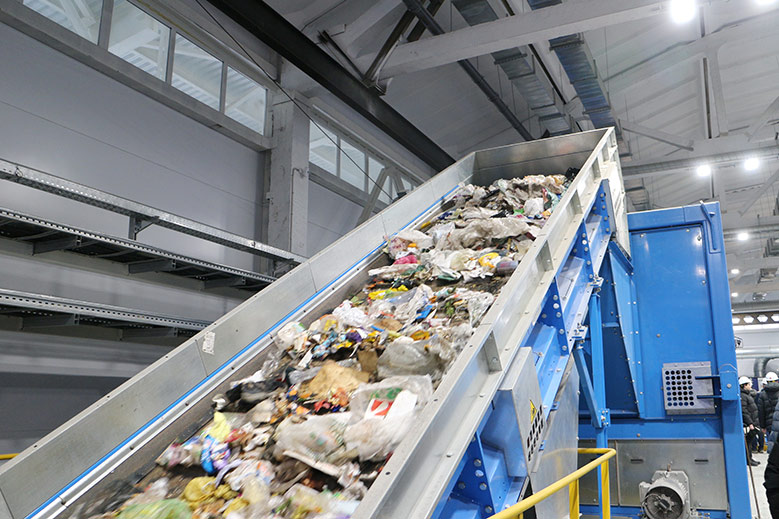Waste and recycling applications are dominated by hydraulic technologies, where the power density, ruggedness, speed and precision they provide are crucial to uptime.
By Josh Cosford, Contributing Editor
Hydraulics have proven to be a versatile and efficient technology in various industries, offering precise control, reliability, and extraordinary power density. Some industries are lightly equipped with hydraulic equipment, such as automation and food and beverage. Conversely, other fields are absolutely dominated by hydraulics, not the least of which is waste management and recycling.
Waste management and recycling is an umbrella term to describe the process and machinery employed by municipalities to collect and process garbage, waste and recycling. It starts at your home or place of business, where steadfast sanitation workers throw your bags or dump your bins into their trucks to haul to transfer stations before being unloaded and processed on-site.

The various materials, ranging from electronics to organic waste, are sorted before being transported to landfills or recycling facilities. It’s an understatement that we take waste management for granted, as it’s an essential aspect of urban living, and it plays a pivotal role in maintaining public health and environmental sustainability.
Power and precision of hydraulic actuation
One of the most recognizable applications of hydraulics in waste management is in waste collection trucks, also known as garbage, refuse, or sanitation trucks. Garbage trucks, whether front-loading, rear-loading, or side-loading, rely on hydraulic systems for lifting and emptying containers, compacting the waste and dumping it at the transfer station. The hydraulic system is equipped with a hydraulic pump mounted to either the PTO of the transmission or the crankshaft.
There are many garbage truck styles, but the most common is the rear-loader. The rear-loader trucks provide a large hopper for workers to toss garbage or recycling into. When the hopper fills, familiar lever-operated valves (or now, more commonly, buttons) at the side of the truck are actuated, and the compactor drops down and pulls the refuse into the body where it is compacted. This truck style also empties its load much like a dump truck, using a telescopic hydraulic cylinder to tip the load to be dumped at the transfer station.
Most other refuse collection vehicles operate with a single driver and collect or dump bins and totes using hydraulic actuators. Many commercial or industrial buildings eschew curbside collection altogether and instead use massive steel bins or large plastic totes. The steel bins are exchanged or dumped by front-loader, roll-off or grapple trucks, which is more typical of non-governmental commercial collection.
The front loader trucks employ tusk-like forks, which extend down and out using hydraulic cylinders before the operator drives forward to insert the forks into the lifting holes of the bin. Again, with cylinders, the load is lifted and inverted overhead, where it dumps the load into the body. The operator often toggles the control valves (or switchgear) to shake the bin to break stuck garbage loose from the sides and bottom, often resulting in a cacophony too familiar to apartment dwellers.
Other common commercial dump trucks are the grapple and hook lift configurations. The grapple truck offers one of the largest payloads, able to pull bins capable of bulky waste or large objects onto the bed using a grapple and (you guessed it) hydraulic winch system. The hook lift truck appears similar but operates with a hydraulic hook that reaches out to grab the leading edge of the bin to pull it onto the chassis.
Hydraulics are the exclusive actuators for garbage trucks because of the high power-to-weight ratio of hydraulic cylinders that make “waste” of the heaviest containers, which are easily lifted and emptied. Finally, the precise control offered by hydraulic systems enables the operators to perform these tasks with accuracy and reliability, ensuring efficient waste collection.
A modern hydraulic technology seemingly perfect for waste collection is the hydraulic hybrid system. Using a hydraulic pump/motor unit and a series of hydropneumatic accumulators offers a powerful and efficient method to recover kinetic energy during frequent stops. The inertia of the slowing vehicle drives the pump to direct hydraulic energy into the accumulators. When the driver accelerates, the pump turns over center to function as a motor where it draws on the stored hydraulic energy to help accelerate the truck.
Compacting and sorting done easily
Waste compactors are crucial for reducing the volume of waste before disposal, making waste management more efficient and reducing the frequency of dump runs. Hydraulic compactors use powerful hydraulic cylinders to compress waste materials, reducing their bulk and making them easier to transport and dispose of. Without a compactor, a garbage truck would transport only a few dozen homes worth of trash. The compactor increases the payload to many thousands of pounds and sometimes up to ten tons or more.

In addition to their truck compaction capabilities, hydraulic compactors are used at recycling and processing sites. Some municipalities may operate more sophisticated recycling programs than others. Still, some may identify up to thirteen different materials that must be separated from the bulk recycling material collected and unloaded from trucks. Paper, plastic, steel and aluminum, to name a few, must be sorted from one another so they can be sold to the appropriate recycling centers. Once sorted, each individual material is compacted using hydraulics and strapped into bales before being trucked off to their respective recycling center.
Hydraulics are the preferred choice for baling machines because of their ability to generate the high forces required for compacting materials. The adaptability of hydraulic systems allows for adjustments in bale size and density, catering to the specific needs of recycling facilities. Moreover, hydraulic baling machines are known for their durability and reliability, ensuring a long service life in demanding recycling environments.
Like landfill sites, recycling centers rely heavily on hydraulic-powered mobile machinery, such as specialized front-end loaders and material handlers, the latter looking like excavators with grapples instead of buckets. Without the power, speed and controllability provided by hydraulics, the handling and transferring of bulk recycling would be tedious, to say the least.
The most critical stage in recycling is the sorting of materials. Recycling facilities utilize conveyor belts and sorting machines equipped with hydraulic systems to separate different materials efficiently. These hydraulic systems control the movement of conveyor belts and the orientation of sorting arms, ensuring that materials like plastics, glass, paper, and metals are correctly categorized and processed.

Hydraulic systems offer a significant advantage in recycling sorting systems due to their precise control and resilience in extreme operating conditions. Many sorting and recycling centers are not climate-controlled, and hydraulics are one of the best machine choices for extreme environments. Oils can be changed to suit seasonal extremes, using high or low-viscosity fluid for summer and winter, respectively.
Withstanding the worst conditions
In some recycling processes, such as plastic recycling, materials need to be further processed before they can be reused. Shredders and extruders are essential in these operations, and they rely on hydraulic power for their functioning.
Shredders equipped with hydraulic systems can efficiently reduce large materials into smaller pieces, making them suitable for recycling. The high torque and force provided by hydraulic motors enable these machines to handle various materials, including plastics, rubber and metal, with ease. So powerful are hydraulic shredders that YouTube channels dedicated to shredding various interesting objects have gained a considerable following.
Hydraulic shredders offer the best solution because of their bulletproof construction and high-torque radial piston motors, which are one of the most efficient hydraulic components on the market. Hydraulic motors can be stalled with no ill effects, and control functions will automatically reverse the shredder blades to remove the jam before restarting again to make quick work of anything from plastic to full-size cars.
Extruders, on the other hand, are used to melt and reshape plastic materials for reuse. Hydraulic systems in extruders control the movement of screws and molds, ensuring precise and consistent processing. The ability to adjust parameters like temperature, pressure, and speed is crucial for achieving the desired quality in recycled products.
Extrusion presses are at their best employing hydraulics. The most extreme extrusion presses also use radial piston motors to turn screws through a heated tube to melt recyclable plastics. The plastics can be drawn, chopped or molded into anything from furniture to films.
Hydraulic machinery and equipment are indispensable in waste management and recycling. They provide the power and control needed to handle waste collection, transportation, and processing efficiently. Whether it’s the lifting arms of a garbage truck, the compaction of waste in a baler, or the sorting and processing of recyclable materials, hydraulics play a critical role in making these operations effective and sustainable.
The advantages of high power-to-weight ratios, precise control, durability, adaptability, and safety features make hydraulic systems the ideal choice for waste management and recycling applications. As these industries continue to grow and adapt to environmental concerns, hydraulics will remain a vital technology in pursuing more sustainable waste management and recycling practices.
Filed Under: Components Oil Coolers, Cylinders & Actuators, Mobile Hydraulic Tips, Pumps & Motors